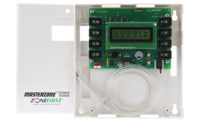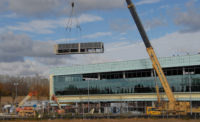CHICAGO — Panasonic Corp. of North America is honing in on its focus to make it easier for both residential and commercial building owners to control the temperature and comfort level within the space. The company hit its targets with the introduction of two new products — the ECONAVI air conditioner and the Variable Refrigerant Flow (VRF) Smart Connectivity Controller. Both products enable users to monitor energy costs, comfort, and other aspects of the indoor space.
“Whether Panasonic’s customers are commercial building owners or homeowners, we know that comfort and energy efficiency are essential,” Malcolm Persaud, senior product manager, Panasonic Appliances Air-Conditioning North America, stated. “With the VRF Smart Connectivity Controller and ECONAVI Intelligent Sensor (not currently available in the U.S.), our products are equipped with smart technology that puts control in the hands of the users and ensures that their needs are met. Additionally, in working closely with our contractor partners across the country, we’ve developed solutions that are easier to install and reduce labor costs.”
The VRF Smart Connectivity Controller is a user-friendly interface that allows building owners to monitor and manage comfort, controllability, and costs for the end user.
Because Panasonic recognized there was a trend in consumers wanting control of their HVAC systems, they developed this solution that is as easy to install as it is to use, according to Persaud.
The controller, developed in conjunction with Schneider Electric, integrates with building management systems (BMS) that utilize BACnet, Modbus, and ZigBee sensors, which makes it a plug-and-play solution for building owners.
A reduction in operating expenses is also a plus with this solution, as it utilizes sensor technology. The sensors detect occupants and the opening and closing of doors and windows to achieve the most efficient energy management. There are other optional sensors available, such as window contact, ceiling-mounted motion, door contact, CO2 sensor, etc.
When asked why it makes a commercial building owner’s life easier, Persaud said it’s all about the easy access and connectivity to the entire building.
“This user-friendly solution dynamically manages comfort, controllability, and costs for the customer,” he said. “Additionally, with this solution, building managers benefit from a sense of controllability that allows them to manage equipment, lighting, security, electrical distribution, and power from a single interface — anytime and anywhere.”
Furthermore, Persaud feels this technology redefines what it means to put control into the building operator’s hands.
“The controller technology sets a new standard for building operators to easily monitor and manage comfort, control, and costs effectively in commercial and light commercial buildings.”
Homeowners often waste energy and money by heating and cooling areas of the home equally, even though some rooms are occupied more often than others. But, Panasonic wanted to see a change, allowing users to have control of where their energy spending goes.
Enter the ECONAVI Air Conditioner with human activity. The two sensors monitor human location, movement, and absence in order to use energy in a more efficient manner.
“It’s all about comfortability and energy savings,” said Eric Griffin, national sales manager, Panasonic Heating and Air Conditioning Group. “And, what this device will do, it keeps an eye on the room, so if there’s not anything going on, it won’t waste any energy. It will slow down the Btu and inverter system, so you’re not wasting energy, and then as more activity and more people enter the room, without having to screw around with a thermostat, the inverter will speed up, Btu will increase, and it will sense the capacity of the people in the room.”
Utilizing Panasonic inverter technology, the air conditioner varies the rotation speed of the compressor, providing a precise method of maintaining the set temperature, energy savings, and comfort at the same time.
Publication date: 2/26/2018






Report Abusive Comment